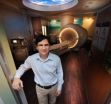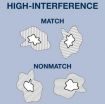(Press-News.org) Water does not forget, says Prof. Boris Koch, a chemist at the Alfred Wegener Institute for Polar and Marine Research in the Helmholtz Association. Irrespective of what happens in the sea: whether the sun shines, algae bloom or a school of dolphins swims through a marine area – everything and everyone leaves biomolecular tracks. With the help of a combination of new techniques, Boris Koch and colleagues can now identify and retrace some of these. In a special volume of the open access journal Biogeosciences, these scientists report on how these analyses work and which events in the sea have so far been uncovered by researchers.
Ponds, peat holes and roadside ditches full of stagnant rainwater were previously of no interest to the chemist Boris Koch. "Then I thought: everyone knows this brown sludge; what could be interesting about it? Today we are working with these very substances that colour the water in roadside ditches brown – or expressed more precisely, with dissolved organic matter which not only occurs in ponds, but of course also in oceans," says Boris Koch, who initiated the research project and is co-editor of the special volume.
It is true that the concentration of these so-called biomolecules per litre of water is lower in oceans than in roadside ditches. However, if we were to tip all of the seawater in the world through a biomolecular porous sieve and convert all the components contained to units of carbon, the relationship would look completely different. It is estimated that the sieve would contain around 25 billion tonnes of stored carbon. This originates primarily from the remains of dead marine organisms and also from the biomass of living whales, fish, algae, bacteria, sea grass and other marine residents. On the other hand, some 662 billion tonnes of dissolved organic carbon would pile up under the sieve, consisting of ten thousands of various substances.
All of these substances aroused Boris Koch's curiosity: "Our work with dissolved organic matter is accompanied by two fundamental difficulties: firstly, to this day we do not know how much organic material reaches the sea or is produced there and why not everything is biodegraded. Secondly, the concentration of individual dissolved biomolecules is so low that we must consistently enrich our water samples so as to be able to study the dissolved organic matter they contain in an ultra-high resolution mass spectrometer at the Helmholtz Zentrum München," explains Koch, who is a co-operative professor at the Alfred Wegener Institute and Bremerhaven University and who lectures on marine chemistry.
With the help of this mass spectrometer at the Helmholtz Zentrum München, the German Research Centre for Environmental Health, the team of scientists working with Boris Koch has for the first time succeeded in identifying thousands of individual components in the dissolved organic matter (DOM) in the course of a single measurement. "The device gives us the chemical formula of each molecule and specifies how much carbon, oxygen, hydrogen or nitrogen it contains. We need this information to find out where the individual molecule might have originated from," Boris Koch explains.
At the end of the analysis in the mass spectrometer a kind of chemical fingerprint is produced which, in the course of statistical calculation, permits concrete conclusions to be made about the water in which the dissolved organic matter once swam in. "We are just beginning our studies. However, it would appear that, using this method, we have discovered a new way of exploiting the water's chemical memory," says Boris Koch. For example, scientists can say how old the dissolved matter is, whether it was exposed to strong sunlight along its path through the oceans or which bacteria and types of plankton probably once swam in the same body of water.
"We can even trace which share of the DOM leaves its tracks in the atmosphere. Foam and waves can transport DOM into the air where it has a considerable influence on climate," adds Dr. Philippe Schmitt-Kopplin from the Institute of Ecological Chemistry at Helmholtz Zentrum München. After all, the most important questions about DOM arise from climate research. Boris Koch: "The dissolved organic matter in the ocean is one of the largest active carbon reservoirs on earth. Previously climate research paid little consideration to its storage capacity, despite the fact that it binds carbon dioxide for periods of 3000 years or more – the average age of our sample material."
The question for scientists at the Alfred Wegener Institute is now to close these gaps in knowledge and to find out more about the role of the DOM in the global carbon cycle. The chemical analysis process could also be used in other sub-disciplines of marine research: "Oceanographers could always draw on the DOM finger print when it is not possible to distinguish water masses solely on the basis of temperature and salt content readings. Furthermore, during one of the next expeditions with the research vessel Polarstern, together with biologists we plan to examine whether the DOM in bodies of water along the migration routes of southern elephant seals demonstrates certain chemical commonalities. Perhaps we will find evidence that these marine mammals find their way using 'water odour'", chemist Boris Koch says.
Personally the new findings mean that he now sees every ditch in a different light. Koch: "We now know that every drop of water contains real chemical information which, thanks to new technology, we are now able to access."
Background knowledge: What is DOM?
Dissolved organic matter, or DOM, in the ocean is one of the largest active, organic carbon reservoirs on earth. The global volume of carbon stored in the DOM (662 billion tonnes) is comparable with the total volume of carbon in atmospheric carbon dioxide (currently 835 billion tonnes) and in land plants (610 billion tonnes). Moreover it exceeds the volume of carbon stored in living marine animals, plants and bacteria (some 3 billion tonnes) by a factor of 200.
The organic matter is formed from atmospheric carbon dioxide by primary producers such as plants and plankton by photosynthesis. This takes place both on land (plants) and in the sea (algae). The DOM formed is either transported to the oceans via rivers or it is directly released in the seawater or sea ice, for example by algae and converted by microbial degradation. In flat coastal waters and the open sea, bacteria take up part of the DOM as their most important source of organic energy. They decompose the material and break it down into its basic components. The carbon dioxide created in the process dissolves in the water and can thereby escape back into the atmosphere.
The other part of the freshly incorporated DOM is initially not broken down by bacteria, but rather chemically modified, and withstands the decomposition process for a period of up to 5000 years. This is an extremely unusual process from a chemical point of view because in principle the oxygen-rich water column should promote rapid microbial degradation of the organic material. The two major questions are now: why are degradation processes interrupted and why does a significant part of the atmospheric carbon remain stored in the DOM of the oceans, circulating them for a long time? In this way marine DOM acts as a buffer in the organic carbon cycle.
Despite the evident major significance of DOM, until now it has been scarcely possible to classify it in the global carbon cycle. The complex composition of the DOM represented an enormous analytical challenge. Consequently, there was insufficient information about the precise sources of the DOM, the formation and degradation processes and its binding mechanisms with minerals and heavy metals.
### END
The chemical memory of seawater
Scientists examine the biomolecules dissolved in the ocean and read them like a history book of the sea
2012-10-01
ELSE PRESS RELEASES FROM THIS DATE:
First images of Landau levels revealed
2012-10-01
Physicists have directly imaged Landau Levels – the quantum levels that determine electron behaviour in a strong magnetic field – for the first time since they were theoretically conceived of by Nobel prize winner Lev Landau in 1930.
Using scanning tunnelling spectroscopy - a spatially resolved probe that interacts directly with the electrons - scientists at institutions including the University of Warwick and Tohoku University have revealed the internal ring-like structure of these Landau Levels at the surface of a semiconductor.
The experimental challenge in the work ...
UK-led project unravels the structures of membrane proteins
2012-10-01
The European Drug Initiative on Channels and Transporters (EDICT), which comes to an end this year, focused on membrane proteins. They make up a third of all proteins in every organism and play a key role in many human diseases.
Membrane proteins are difficult to study and poorly understood, but the four-year EDICT project has enabled a major step forward in our understanding of the structures – and even more importantly the functions – of over 30 of these proteins. Bringing together over 100 researchers across 12 countries, the project has developed better and faster ...
'Green Brain' project to create an autonomous flying robot with a honey bee brain
2012-10-01
Scientists at the Universities of Sheffield and Sussex are embarking on an ambitious project to produce the first accurate computer models of a honey bee brain in a bid to advance our understanding of Artificial Intelligence (AI), and how animals think.
The team will build models of the systems in the brain that govern a honey bee's vision and sense of smell. Using this information, the researchers aim to create the first flying robot able to sense and act as autonomously as a bee, rather than just carry out a pre-programmed set of instructions.
If successful, this ...
Yearlong MAGIC climate study launches
2012-10-01
UPTON, NY - A Horizon Lines container ship outfitted with meteorological and atmospheric instruments installed by U.S. Department of Energy (DOE) scientists from Argonne National Laboratory and Brookhaven National Laboratory will begin taking data today for a yearlong mission aimed at improving the representation of clouds in climate models. The study, a collaborative effort between DOE's Atmospheric Radiation Measurement (ARM) program Climate Research Facility and Horizon Lines, marks the first official marine deployment of the second ARM Mobile Facility, AMF2, and is ...
Nothing to sneeze at: Scientists find cheating ragweed behaves better with its kin
2012-10-01
Cheating. Conflict. Competition. It may sound like a soap opera but this is the complex life of the despised ragweed plant.
And in the highly competitive fight for nutrients, researchers have found ragweed will behave altruistically with its siblings, investing precious resources for the benefit of the group.
A growing body of work suggests plants recognize and respond to the presence and identity of their neighbours and the findings, published online in the journal PLOS ONE, provide further evidence of the importance of family in preserving cooperation within and ...
Evidence-based guidelines enable optimal treatment of common low-back pain
2012-10-01
AUGUSTA, Ga. – While scientific evidence suggests that less is typically more when it comes to diagnosing and treating low-back pain in the U.S., the number of expensive imaging exams and surgeries done on patients continues to rise, researchers say.
More than 25 percent of American adults report at least one episode of acute low-back pain in the past three months and the annual total price tag is about $100 billion, according to a study in an issue of the Journal of the American College of Radiology focusing on health care reform.
"For the great majority of patients, ...
Longest fiber-optic sensor network developed
2012-10-01
This press release is available in Spanish.Montserrat Fernández-Vallejo, a telecommunications engineer and graduate of the UPNA-Public University of Navarre, has experimentally developed various fibre-optic sensor networks for the remote monitoring of large infrastructures. Specifically, she has managed to develop the largest network so far in existence —measuring 250 km—, which is equipped with a multiplexing capability, (which enables two or more information channels to be combined within a single transmission medium).
This technological development in the field of ...
EARTH: Risky business: Modeling catastrophes
2012-10-01
Alexandria, VA – The probability that a given natural hazard could become a natural disaster is higher today than at any previous point in history, largely because of population growth putting more people and infrastructure in harm's way. Who pays for the damage and how is value and risk assessed? Much of it comes down to insurance and reinsurance agencies, which are relying more and more on sophisticated catastrophe modeling tools to help gauge when the next disaster will strike, and how much it will cost.
Catastrophe modeling has only been around for a couple of decades, ...
Baby communication gives clues to autism
2012-10-01
CORAL GABLES, FL -- Approximately 19 percent of children with a sibling diagnosed with Autism Spectrum Disorder (ASD) will develop Autism due to shared genetic and environmental vulnerabilities, according to previous studies. For that reason, University of Miami (UM) psychologists are developing ways to predict the occurrence of ASD in high-risk children, early in life, in hopes that early intervention will lead to better outcomes in the future. Their findings are published in the journal Infancy.
The study is one of the first to show that measures of non-verbal communication ...
Eliminating visual clutter helps people with mild cognitive impairment
2012-10-01
A new study from Georgia Tech and the University of Toronto suggests that memory impairments for people diagnosed with early stage Alzheimer's disease may be due, in part, to problems in determining the differences between similar objects. The findings also support growing research indicating that a part of the brain once believed to support memory exclusively – the medial temporal lobe - also plays a role in object perception. The results are published in the October edition of Hippocampus.
Mild cognitive impairment (MCI) is a disorder commonly thought to be a precursor ...
LAST 30 PRESS RELEASES:
Manta rays create mobile ecosystems, study finds
Study: Mixed results in using lipoic acid to treat progressive multiple sclerosis
Norbert Holtkamp appointed director of Fermi National Accelerator Laboratory
New agentic AI platform accelerates advanced optics design
Biologists discover neurons use physical signals — not electricity — to stabilize communication
Researchers discover that a hormone can access the brain by hitchhiking
University of Oklahoma researcher awarded funding to pursue AI-powered material design
Exploring how the visual system recovers following injury
Support for parents with infants at pediatric check-ups leads to better reading and math skills in elementary school
Kids’ behavioral health is a growing share of family health costs
Day & night: Cancer disrupts the brain’s natural rhythm
COVID-19 vaccination significantly reduces risk to pregnant women and baby
The role of vaccination in maternal and perinatal outcomes associated with COVID-19 in pregnancy
Mayo Clinic smartwatch system helps parents shorten and defuse children's severe tantrums early
Behavioral health spending spikes to 40% of all children’s health expenditures, nearly doubling in a decade
Digital cognitive behavioral treatment for generalized anxiety disorder
Expenditures for pediatric behavioral health care over time and estimated family financial burden
Air conditioning in nursing homes and mortality during extreme heat
The Alps to lose a record number of glaciers in the next decade
What makes a good proton conductor?
New science reporting guide published for journalists in Bulgaria
New international study reveals major survival gaps among children with cancer
New science reporting guide published for journalists in Turkey
Scientists develop a smarter mRNA therapy that knows which cells to target
Neuroanatomy-informed brain–machine hybrid intelligence for robust acoustic target detection
Eight SwRI hydrogen projects funded by ENERGYWERX
The Lundquist Institute and its start-up company Vitalex Biosciences Announces Strategic Advancement of Second-Generation fungal Vaccine VXV-01 through Phase 1 Trials under $40 Million Competitive Con
Fine particles in pollution are associated with early signs of autoimmune disease
Review article | Towards a Global Ground-Based Earth Observatory (GGBEO): Leveraging existing systems and networks
Penn and UMich create world’s smallest programmable, autonomous robots
[Press-News.org] The chemical memory of seawaterScientists examine the biomolecules dissolved in the ocean and read them like a history book of the sea



